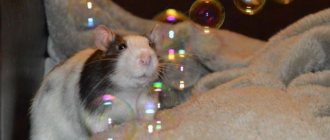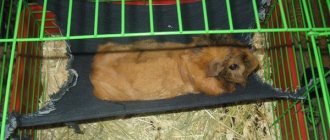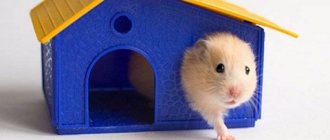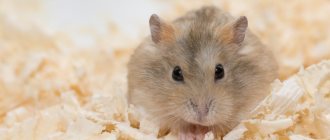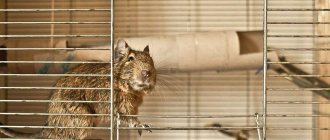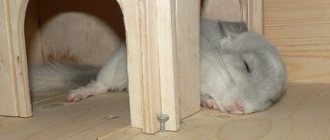Have you got pet rats? Congratulations! These are one of the most affectionate, intelligent and loyal pets. They will quickly fall in love with your company and will sit on your shoulder for hours, watching what you do. If you don’t have free time to take care of your charges, then make sure that they don’t get bored in your absence - make your own toys for rats. This will be the first part of the material devoted to this topic. Continue reading about how to make a toy for a rat in the next article. Here is a small list of cheap and simple ideas for organizing entertainment and creating toys for your rodents.
- Digging box - allows your pets to realize their natural urge to dig for something.
- Fishing peas out of water is a fun game that will help keep your kitty rats cool on hot summer days.
- A rat piñata, a hollow paper toy with treats inside, is great entertainment for caged rodents combined with exercise for your pet's health.
- Delicious garlands will briefly decorate the cage and make your pets happy.
- Soft Tunnel – Your rats will love crawling through this simple toy.
- Hammocks are a great place to relax.
- Rat Litter Bin – Give your rats a chance to make a mess.
- Rat town is a place for games and hide and seek.
- Rat grain bag is a place to rest in both winter and summer.
- Rat Party Games – Are you ready for your rat's birthday?
Digging box
For your kitty rats, one of their favorite toys may be a digging box. In it, your rats will be able to rummage in the ground, get ungerminated seeds, nibble on green grass and feast on roots. On a hot summer day, your pets will often spend time in the cool ditches dug into the ground of the box. If your rats don't already have a box like this, be sure to make one!
- Get a fairly large box or tray. A plastic box measuring 40x30x20 cm will work well. You can even use a cardboard box, but it really won’t last long.
- Fill half the box with clean soil. Use sterile soil from a garden center that is free of fertilizers, chemicals and insects.
- Scatter a handful of birdseed (such as parrot seed mix) into the soil and water lightly.
- Wait a few days for the seeds to germinate. In less than a week you will have a good harvest of “grass”. Sprouted roots will also bind the soil and prevent your pets from scattering it. 2 days before introducing a new toy to your rats, stop watering the grass - the tailed rodents will not get dirty in the mud on the very first day of exploring a new entertainment.
- Place the digging box in an area that is easy to clean (such as a bathtub, shower, or place several plastic sheets under the box).
- Place the rats in the prepared box.
In order to immediately interest your pets in a new toy, you can throw some of their favorite treats on the ground (or bury them). Having become familiar with the new entertainment, your pet rats will chew the grass, look for ungerminated seeds, frolic and hide in the grass, unexpectedly jumping out of the thickets at their relatives, and simply dig and rummage in the ground... Ultimately, they will have dirty paws and noses, but happy and satisfied. And yes, you will have to clean up the place where the box with the earth is placed, since the earth will be scattered around it.
For little rats, you can make your own safe, clean “digging box” by filling the box with pieces of fabric.
Fishing peas out of water
This fun game will help your rats cool down on hot summer days.
- Get a shallow tray that is large enough to accommodate your pets. The roller tray is ideal because it has a deep edge on one side and a shallow, slightly sloping edge on the other (like in a swimming pool).
- Fill the tray with a small amount of water.
- Place the tray of water on something waterproof (such as the bathroom floor or a plastic sheet).
- Have dry towels ready to immediately wipe off wet rats before they sneak into the room. There is no need to create dampness in the house again.
- Throw a few frozen peas into the water (you can use corn if your pets like it).
- Now you can let your rats into the tray.
Rats will definitely enjoy splashing in the water, especially since there will be peas in it, which is a treat for them. Some will jump straight into the water after their prey, while others will begin to catch peas with their paws without entering the pool. In any case, they will love this entertainment!
We will set up an indoor play area
First, you need to clear the area of anything that could harm your rats. While the play area will be enclosed with a barrier, the rodent may be harmed by bright lights, vents, and electrical wires. Clear the area of chemicals, wires, sharp objects and anything that gives off smoke, such as candles.
Choose a location away from walkways and other pets. The best place for a play area would be a corner in the living room with a wooden floor. Just keep the play area clear of things that you don't want to get damaged or become chewed on.
Rat pinata
Piñata is a game in which various sweets are placed inside a hollow tube and, once sealed, hung higher. And then the participants in the game take a stick and hit the pipe until treats begin to fall out of it. The same kind of entertainment can be done for domestic rodents - you will get an excellent toy for rats with your own hands.
- Place several paper towels together. The older and smarter your rats are, the more layers of paper you need, or you can use a cardboard tube from a toilet paper roll, folding the edges of the tube inward.
- Place a handful of peas, corn, sunflower seeds, cereal, a few drops of yogurt or another treat that your tailed pets love in the paper.
- Roll the paper into a tight bundle and tie it carefully with ribbon or string.
- Hang the bundle high in the cage so that it dangles freely, and your pets can reach it only by standing on their hind legs.
- Now you can let your pet rats into the cage.
When the rats smell the treat, they, following their instincts, will begin to reach for the package and try to get it. They will have to work hard to cope with the task. But the more difficult the treat is to get, the tastier it is. In addition, it will be a good exercise aimed at maintaining the physical fitness and health of your pets.
What are they?
There are many simple yet fun toys you can give to your pet rat or mouse to make them happier.
- Tunnels. Rats and mice by nature make and use burrows or tunnels. You can provide ready-made tunnels or let them make their own. You can buy or make tunnels from plastic and place them in a cage, hanging them on stainless steel hangers. You can create your own shape models and create a whole network of labyrinths. Plastic is easy to clean. Be sure to choose a pipe with a fairly large diameter so that the rodent cannot get stuck in it.
You can drill a hole for a tunnel in a piece of wood; in addition to climbing, rodents can use such a wooden tunnel for cleaning their teeth and gnawing on their new toy with pleasure.
- Wheels and balls for training. Exercise wheels provide a great way for your rodent to exercise within the confines of his cage. Be sure to choose a safe wheel that will not damage its legs or tail. Solid wheels are definitely preferable to lattice wheels. Rats usually require 28 cm diameter wheels. Some wheels can be hung from the top or side of the cage. Exercise balls also provide a good workout outside the cage.
Related Article: Rat House: Choosing, Designing and Making Your Own
Always supervise your pet while he is playing with an exercise ball to make sure he doesn't get injured and is actually in a safe place. The ball should be kept away from stairs and other dangerous objects.
- Climbing toys: Ladders, ropes, branches, pipes, hammocks and other items can provide plenty of climbing options for your pet mouse or rat. They can be attached to the top and sides of the cage to greatly increase the play area of the cage. You can also use bricks and concrete blocks if the cage is quite large.
- Toys that rats and mice will happily chew on. Wooden blocks, for example, should be in the cage of the pet rat and mouse so that they can chew on them. This is essential for dental health as teeth continue to grow and need to be constantly cleaned and filed down. Chew toys can be made of wood or cardboard. Inexpensive chew toys can be made from cardboard boxes, paper towel tubes, and toilet paper.
- Chopping toys . Mice and rats love to shred softer materials such as toilet paper and straw. Grinding such materials is enjoyable for rodents and provides great entertainment.
- Push and carry toys. Many rats like small toys that they can carry or push. Plastic balls with a small bell inside, for example, make a great toy for your rat. Never give your favorite rodent toys made of soft rubber, the rat can chew it and swallow a small piece, and this will cause intestinal obstruction. Always keep an eye on your pet's habits to make sure the toys they have are still safe.
- Toys for walking. In the wild, rats and mice spend most of their waking time searching for food. Too often we simply fill the bowl with food, so your pet can soon become lazy and overweight.
Article on the topic: How to play with a decorative rat at home
Among other things, it is worth providing mental stimulation to your pet rats or mice by hiding, for example, a special toy in their food. There are many bird feeding toys that can also be used for rodents, such as bamboo pieces. You can pour food into the bamboo and watch how your rodent takes it out. Use your imagination and you can give your favorite mouse or rat toys that will bring them great pleasure.
Delicious garlands for rats
On Christmas, New Year, Birthday and other holidays, don’t forget about gifts for your tailed pets. To cheer them up on special occasions, decorate their cage with delicious garlands.
- Take a needle and thread a strong cotton thread through it.
- Select an assortment of rat treats to string (preferably non-perishable ones). For example: popcorn, grapes, dried fruits, cereal, peanuts in shells. You can even use cheese, bread or pieces of fruit, as long as you do not leave the garlands of these products for a long time.
- String treats one at a time to make the garland colorful and interesting.
- Hang a delicious garland high in the cage.
- Now you can let your pet rats into the cage.
Your pets will have fun gnawing on their favorite treats, taking them out from the garland and at the same time complementing the festive atmosphere of your home.
Soft tunnel for rats
This is a very simple and easy to make rat toy, although it does require some basic sewing skills.
- Get a piece of fleece or other inexpensive fabric such as cotton.
- Cut a piece measuring 30-40cm wide and 1-2m long, or any other size you like. Focus on the planned dimensions of the finished product.
- Sew a rat tunnel. A sewing machine is perfect for this purpose, but you can also sew the toy by hand.
- If you are creative and skillful enough, add several branches, intersections and separate rooms to the tunnel to create a kind of labyrinth.
- Cut 10 cm long rings from a plastic bottle and attach them to the ends of the tunnel. This will keep the exits from the soft tunnel open.
- Introduce your rats to a new homemade toy.
The rats will enjoy chasing each other in the soft tunnel, and the more branches it has, the better. This toy can easily be folded up when not in use or thrown in the wash if your tailed rodents accidentally pee in it.
What toys for rats can you make yourself? Features of material and product selection
Many people decide to get a pet, but not everyone wants to have a large animal, since they need to devote a lot of time to it, and it is also very difficult to maintain such a pet in an apartment. Therefore, an excellent solution would be to get a decorative rat, but this does not mean that the rodent does not require your attention and time. At first, the animal will behave warily and even aggressively, but when it gets used to its new home and its territory, and also understands that nothing threatens it, its behavior will return to normal. The pet will spend most of the day on its own; there are various toys for rats, with the help of which the rodent will be able to fill the lack of attention from the owner. Such products are sold in special pet stores, and you can also make them yourself with your own hands.
Hammocks for rats
Rats love hammocks! This is a great place to relax. There are many ways to make them yourself. Here are some simple ideas:
- Ordinary hammock. Cut off one leg of old jeans (select the length based on the size of the cage), pass two ropes through it and tie the resulting hammock in a rat cage. You can use an old face towel or cut a piece of thick fabric to size, make a hole in each corner, thread string or string through it, and tie it to the bars of the cage. The hammock can be attached to the bars of the cage and using large pins or shower curtain hooks - this will allow you to quickly and easily remove the hammock for washing.
- Hammock with pocket. Cut a piece of thick fabric to the required dimensions. Fold it so that the top covers 3/4 of the bottom. Sew up the sides. Attach the hammock to the cage using ropes or hooks. Rats will be able to relax on the hammock on top or burrow into a pocket if they get cold. This hammock with a pocket is ideal in winter, especially if it is made of warm fleece.
- Hammock. Cut two identical pins from wood and insert them between the bars of the cage at the same level. You will end up with something that looks like a bird's perch. Cut a suitable size pant leg from old jeans (you can use other thick fabric) and sew along the edges. Now stretch the fabric over the wooden dowels. You should now have a hanging bunk. The fabric should not be too stretched, but should sag a little.
- Attics. Cut the leg of your old jeans to the required size. Thread two pieces of rope through the cut piece and tie them relatively close together to the bars of the cage, so that the pant leg piece is pulled up at the top and down at the bottom. You should end up with a triangle with the base at the top that your rats can crawl into. Alternatively, you can make four holes in the top of the denim leg and tie them to the bars of the cage with string. To create even more comfort for your pets, you can close the “loft” on one side.
- Soft descent. Cut a piece of thick fabric and tie it well to the high and low shelves. There should be a soft descent from floor to floor. Your rats will climb up it and smoothly slide down. It will be a good alternative to stairs or ramps.
- Rat bag. Cut a piece of thick fabric to the required dimensions. Fold it so that the top covers 3/4 of the bottom. Sew up the sides. It is better to make the upper part a little wider (trapezoid), so after sewing the sides, the resulting bag will always be slightly open. Attach the top two corners of the rat pouch to the cage using ropes or hooks. Rats will be able to climb into a hanging bag and rest quietly in it, hidden from prying eyes.
- Cozy pouch. Such products can be sewn from thick fabric or fleece, or you can simply use a small old bag. Place the finished bag on the floor of the cage and secure its upper edge with a hook or rope so that the entrance is always open. It is better to place such cozy bags under stairs and ramps. Your pets will love to sleep, play or fight inside them.
When making your own rat hammock, make two. A spare hammock will always come in handy when the first one is in the wash or gets torn to shreds.
Wood
The rat always needs to chew on something. A wooden toy is perfect for this. Wooden branches will do this role perfectly.
Branches of trees such as apple, pear, quince, and currant are considered safe for rodents. Twigs of hazel, willow, birch, linden, and rowan are also suitable. Branches should be collected away from the road and keep in mind that some trees may be treated with pest control agents.
To ensure that the material is safe for the rat, the wood can be roasted in the oven or washed in boiling water and dried.
Using dense threads and wooden branches, you can build various ladders and crossbars.
Of course, if you are involved in woodworking, you can make wooden rings and any other shapes from wood that is approved for rats.
Naturally, wooden products must be well processed to avoid splinters. Wood cannot be painted or varnished.
Rat trash bin
Rats love nothing more than to rummage through drawers for scraps of food, throwing everything around and tearing to pieces paper, cardboard and other materials that get in their way. In short, your trash can is their best playground. But you certainly don't want to leave your household's trash bin to be torn to pieces, so why not make your own for them. Give your rats a chance to create a controlled mess.
- Take a cardboard box or plastic bucket (box).
- Find trash that your rats will enjoy: crumpled up newspapers, cereal boxes, scraps of fabric, old paperback books, empty cut-up plastic bottles, old magazines, wine corks, etc.
- Add some non-perishable products to the selected garbage: nuts in shells, oatmeal, drops of yogurt, etc. Hide the treat well, for example in rolled paper.
- Place a box of trash in the corner of the rat's home and tell them, “No! You can’t play in this box!”
